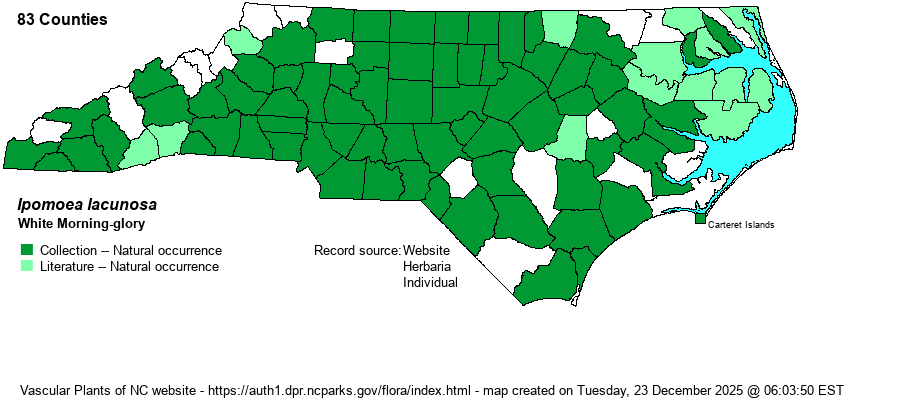| Author | L. | |
| Distribution | Throughout the Piedmont and most of the western and central Coastal Plain; scarce but spreading in the eastern counties and likely occurs in all of them. Scattered in the Mountains.
This is a widespread Southeastern species, ranging from NJ and IA south to southern FL and eastern TX.
| |
| Abundance | Common in the Piedmont and the western and central Coastal Plain, but rare to uncommon farther east to the northeastern coast. Uncommon to infrequent in the southern half of the Mountains, but perhaps absent in northern counties. The NCNHP's State Rank of S4 is overly conservative, and it is obviously S5. | |
| Habitat | This is a species that favors damp ground, such as marshes, wet thickets, and edges and openings of bottomlands. However, it also grows in more mesic sunny places such as wooded edges and various thicket margins. | |
| Phenology | Blooms from July to frost, and fruits soon after flowering. | |
| Identification | Unlike several other morning-glories that may or may not be native in the state (i.e., I. coccinea and I. hederacea), this one definitely is! It is a slender, herbaceous vine, growing to 6-8 feet long, and twining over other vegetation. The alternate leaves can be either simply cordate with no side lobes, or have two side lobes (i.e., 3-lobed); in either case, the blades are about 2-3 inches long and almost as wide. The axillary flowers are quite small, from 1-5 at a node; each is only about 3/4-inch across and long, normally white in color, and also white in the throat. Thus, a morning-glory with all-white flowers about the size of a penny or nickel across the opening will be this common species. | |
| Taxonomic Comments | None
| |
| Other Common Name(s) | Whitestar, Pitted Morning-glory, Small White Morning-glory | |
| State Rank | S4 [S5] | |
| Global Rank | G5? | |
| State Status | | |
| US Status | | |
| USACE-agcp | FAC link |
| USACE-emp | FACW link |

